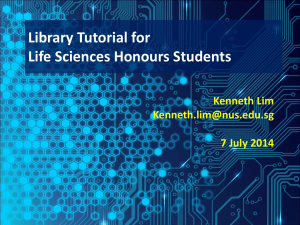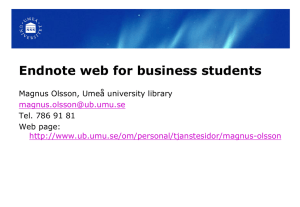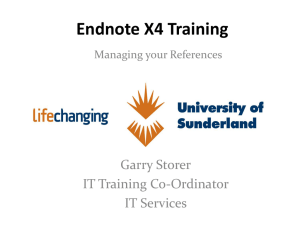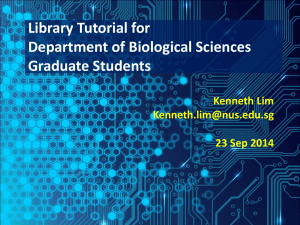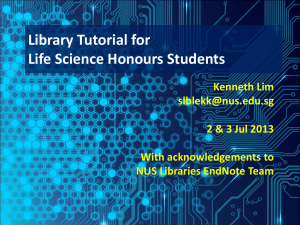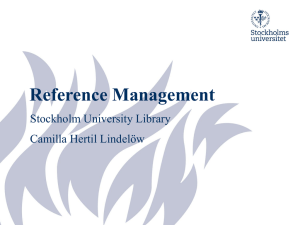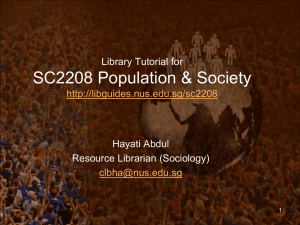Library Tutorial for Life Sciences Honours & DBS
advertisement
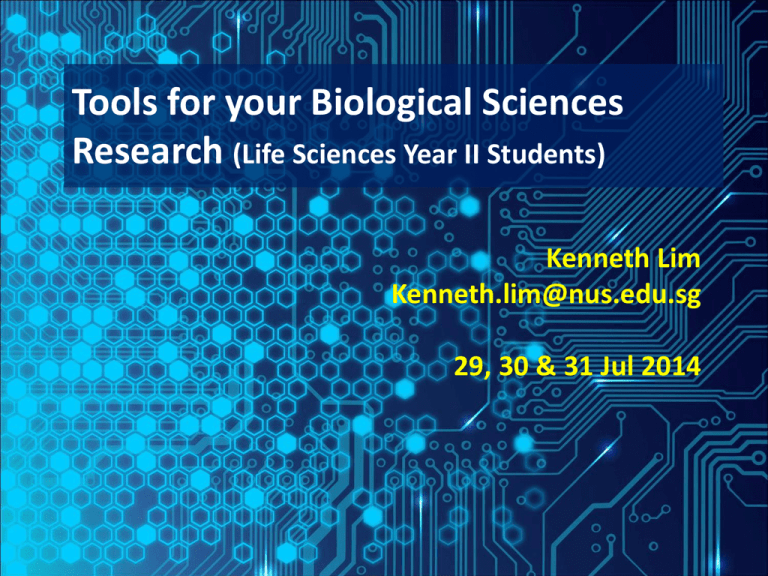
Tools for your Biological Sciences Research (Life Sciences Year II Students) Kenneth Lim Kenneth.lim@nus.edu.sg 29, 30 & 31 Jul 2014 Outline • Using the Library • Overview of Search Strategies • Information Sources & Evaluation • Citations & Plagiarism • Bibliographic Software & Introduction to EndNote • Guides, Tools and Tips 2 NUS Libraries Portal (http://www.lib.nus.edu.sg) 3 Loan Entitlement for Undergraduates 20 items 14 days 3 renewals How do I Borrow a Book? FAQ: http://libfaq.nus.edu.sg/a.php?qid=79581 http://www.battenkillbooks.com/wp-content/uploads/2011/10/stack_of_books21.jpg 4 Literature Search Cycle Breakdown the Research topic into concepts Manage Citations Locate Additional Information Sources Identify key Information Sources Develop a Search Strategy http://libguides.nus.edu.sg/content.php?pid=165681&sid=1733290 5 Types of Database Searches • Keyword / Phrase Search e.g. Using “horseshoe crab” in Web of Science /Google • Field Search e.g. Using Raffles Bulletin of Zoology in the Publication Name field in Zoological Record • Subject Heading / Thesaurus Search e.g. Using neoplasms (instead of cancer) as a MeSH (Medical Subject Headings) term in PubMed 6 Boolean Connectors OR - either of the terms may be present. Used for broadening a search e.g. roundworms OR nematodes AND - both terms must be present. Used for narrowing a search. e.g. parasites AND intestine NOT - eliminate an unwanted concept or word e.g. parasites NOT flatworms ( ) – grouping words or phrases and specifying the order in which Boolean operations occur when multiple operations are present e.g. (A OR B) AND C A OR (B AND C) 7 Exact vs. Wildcard Search “ ’’- searches the exact phrase enclosed within the quotes e.g. “avian influenza” * - represent any group of characters or no characters (useful for representing various forms of a term) e.g. biol* - for biology, biological, biologist, biologists ? - represent any single character (useful for singular/plural forms) e.g. cat? - for cat, cats $ - represent one character or no characters e.g. behavio$r , colo$r , vapo$r (useful for finding both British & American spellings) Note: Wildcards and usage are dependent on the database 8 Types of Information Sources Information Sources Examples Primary Sources Presents the original research information and empirical data. Current Secondary Sources Review or restate information in Primary Sources or other Secondary Sources. •Experimental results •Theses & Dissertations •Conference Proceedings •Journal articles •Review articles •Bibliographies •Databases Tertiary Sources •Dictionaries Provides overviews of topics by synthesizing •Encyclopedias information gathered from other sources. •Textbooks Dated 9 Recommended Online Resources Type of Information Recommended E-Resource Multi-disciplinary Bibliographic Databases Web of Science / Scopus Biomedical & Life Sciences BIOSIS Previews Animal Biology & Taxonomic Reference Zoological Record Medicine, Dentistry, Pharmacy, Healthcare & Life Sciences PubMed (MEDLINE) Experimental Protocols and Demonstration Videos Springer Protocols Wiley Current Protocols JoVE (Journal of Visualized Experiments) Chemical Substance Structure / Properties & Reaction Searching Reaxys / SciFinder (registration) Newspaper Articles / Local Content Factiva / Lexis-Nexis / NewspaperSG 10 10 Guidelines for Evaluation of Resources Criteria Questions Authority Author’s Credentials, Subject Expert? Accuracy Information is Valid and Reliable Objectivity & Purpose Any Bias? Review process Publication Peer-Reviewed? Suitability Academic /Scholarly Journal (Journal Impact Factor, Immediacy Index) Timeliness When was the Information published? 11 Production of Limulus Amebocyte Lysate (LAL) Source: http://www.wired.com/magazine/2011/06/st_processcrab/?pid=5836&viewall=true 12 Alternative: recombinant Factor-C (r-FC) http://media.drugdevcompare.com/m/7/Product/57499-1-400x300.jpg http://media.drugdevcompare.com/m/7/Product/57499-2-400x300.jpg 13 Research Topics Topic 1: Population studies of Asian Horseshoe Crabs Topic 2: Limulus Amebocyte Lysate (LAL) and Recombinant Factor C (rFC) as tests for airborne endotoxins 14 Image Source: http://animals.m-y-d-s.com/aquatic/horseshoe_crab/ Construction of Search Statement Step 1: Identify concepts/keywords Limulus Amebocyte Lysate (LAL) and Recombinant Factor C (rFC) as tests for airborne endotoxins Step 2: Generate synonyms, alternate terms, abbreviations airborne: air, aerial, dust, aerosol endotoxin: pyrogen, lippopolysaccharide, LPS Step 3: Construct search statement (initial search) (endotoxin* AND (air* OR dust*)) AND ("limulus amebocyte lysate" OR "recombinant factor c" ) 15 Plagiarism • What is Plagiarism? • A piece of writing that has been copied from someone else and presented as being your own work. The American Heritage Dictionary of the English Language (4th Ed.) • The act of taking someone’s words or ideas as if they were your own. • Avoiding Plagiarism • CIT Preventing Plagiarism site http://www.cit.nus.edu.sg/plagiarism-prevention/ • Proper citation of information sources • turnitin software • Plagiarism Spectrum http://turnitin.com/assets/en_us/media/plagiarism_spectrum.php 16 Citations & Bibliography Two places to cite the references you have used: • within a sentence (in-text citation) • at the end of the document (bibliography/references) 17 Why cite? • To acknowledge the contributor(s) of ideas used in writings • To lend support to arguments by referring to authoritative sources • To help readers verify your claims • To show research done 18 Introduction to Bibliographic Software & EndNote A software that: • stores and organises references from many sources • inserts these references into a Word document, and • automatically formats your references according to a predefined citation style Comparison of Reference Management Software 19 EndNote Online Guide http://libguides.nus.edu.sg/endnote http://libguides.nus.edu.sg/endnote EndNote Workflow 1. Create an EndNote Library 2. Add references to the EndNote Library 3. Manage references: using groups & finding duplicates 4. Insert references in MS Word (Cite While You Write) 5. Change citation style and edit preferences 21 Step 1: Create an EndNote Library a. b. c. d. Hands-on All programs > EndNote > EndNote Program File > New Filename: Test (*.enl) Save 22 Step 2: Add References to the Library Direct Export Import Text File Online Search Import PDF Manual Inputting EndNote Library MS Word Cite While You Write 23 Method 1: Direct Export Export references directly from database a. At the database, select the records you want b. Save, output, export or send to EndNote (Look for “RIS format”) c. Click Open to transfer records to your EndNote library 24 Method 2: Import .txt File Used when references cannot be exported to EndNote. Very few databases e.g. Factiva a. At the database, select the records you want b. Export text (.txt) file and save on desktop c. In EndNote, go to File > Import d. Browse and select the .txt file e. Select Import option > Other filters Which filter to use? http://libguides.nus.edu.sg/content.php?pid=96551&sid=3508846 25 Method 3: Online Search NATL Search free databases (e.g. PubMed) and library catalogues (e.g. LINC, Library of Congress) a. Go to Online Search Mode > More b. Select a free database or catalogue, e.g. NATL U of Singapore c. In the online search pane, search by exact title of book or conference proceeding d. Copy the reference to Local Library Mode 26 Method 4: Import PDF Files Extracts references from PDF files PDF must contain a Digital Object Identifer (DOI) and is not a scanned document. a. In EndNote, go to File > Import b. Choose either file or folder, and change Import Option > PDF Note: If the author, title, journal, etc, fields are not auto-populated, the PDF could be of the wrong format or have an incorrect DOI New in X7 - PDF auto-import folder Whats new in EndNote X7 (Video) 27 Method 5: Manual Inputting Video: http://youtu.be/30u5_b9d5D4 28 Step 3: Duplicate References To set criteria: • Edit > Preferences > Duplicates To find duplicates: • References > Find Duplicates 29 Managing References: Custom vs. Smart Groups Custom Groups Create folders to group (categorise) references Smart Groups Automatically group references based on your search criteria, e.g.: author/year/title contains/is/word begins with… Note: Any references added to EndNote will be automatically filed in the group, with immediate effect 30 Step 4: Cite While You Write (CWYW) • Use MS Word to insert citations into your paper • Create a paper with properly formatted references, bibliography, figures & tables • Tip: Do NOT edit the citations and bibliographies in Word. Edit the reference in the EndNote Library only • Tip: To locate citation and bibliography fields, change the MS Word’s Field Shading option 31 EndNote Tab & Field Shading If EndNote is properly installed, you will see the EndNote tab in Word After you add references, Field shading shows up as text highlighted in grey. 32 Inserting Citations Method 1: Find Citation a. EndNote X7 tab: Insert citation > Find Citation b. Search for a word in any field (e.g. title, author) c. Select the references that you want to insert into your paper Method 2: Insert Selected Citation(s) a.In EndNote library, select a citation b.Go to Word and place cursor at insertion point c.Click on Insert Citation > Insert Selected Citation(s) 33 Editing Citations & References Edit & Manage Citation(s) E.g. add page numbers, exclude author, exclude year Edit Library Reference(s) Place cursor in the citation, click on Edit library references and make the necessary changes. Next, click on Update citations and bibliography 34 Step 5: Change Style & Create a Bib Section To change the citation style EndNote X7 tab: Click on Style > Select Another Style… To create bibliography section* a. Bottom right corner of Bibliography group > Layout > Bibliography title b. Type References (or Bibliography) *The bibliography section appears only when you insert a citation *New in X7 - Create sections within Bibliography 35 Backing Up Library (1) Method 1: Save a Copy Creates an exact copy of the library xxx Copy.Data and xxx Copy.enl • File > Save a Copy… 36 Online Database Guides & Resources • Biological & Life Sciences Subject Guide http://libguides.nus.edu.sg/biology • PubMed Resources http://www.nlm.nih.gov/bsd/disted/pubmedtutorial/ • Web of Science (includes BIOSIS Previews & Zoological Record) http://wokinfo.com/training_support/training/ • Scopus Resources http://help.scopus.com/Content/h_tutorials.htm 37 Library Proxy Stem/Bookmarklet NUS Libraries Proxy Stem http://libproxy1.nus.edu.sg/login?url= e.g. Prefix a URL with the NUS Libraries Proxy Stem http://www.springerlink.com/content/e440n0431724460v/ http://libproxy1.nus.edu.sg/login?url=http://www.springerlink.c om/content/e440n0431724460v/ Installing the NUS Libraries Proxy Bookmarklet: FAQ: http://libguides.nus.edu.sg/content.php?pid=199108&sid=1665223 38 Accessing Full-Text via Google Scholar Setting up NUS Libraries access in Google Scholar : FAQ: http://libfaq.nus.edu.sg/a.php?qid=260648 Alternate direct link: http://scholar.google.com/schhp?hl=en&inst=13660462560571941651 39 Accessing Full-Text via PubMed Setting up NUS Libraries access in PubMed: FAQ: http://libfaq.nus.edu.sg/a.php?qid=260692#.US2nFFeQg8k Direct link: http://libproxy1.nus.edu.sg/login?url=http://www.ncbi.nlm.nih.gov/pubmed? myncbishare=nuslib&holding=isgnuslib_fft 40 Thank You! Please fill in the feedback form at: http://bit.ly/bsf31Jul14 Contact me at: Kenneth Lim kenneth.lim@nus.edu.sg Science Library sclib@nus.edu.sg 41 NUS Libraries Games & Lucky Draws 28 Aug 2014 10am - 5pm Book Sale Proceeds go to NUS Annual Giving Bursary 28 - 29 Aug 2014 http://j.mp/erdd2014 Knowledge Without Boundaries!

